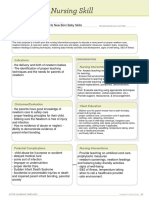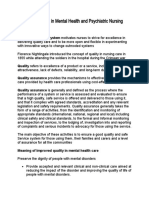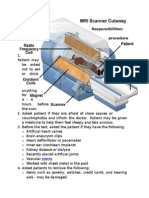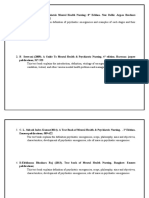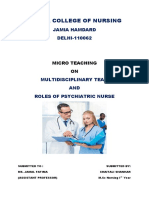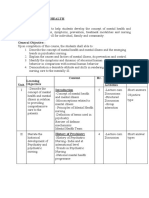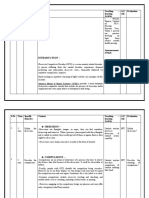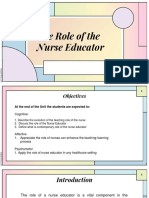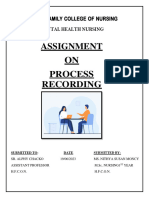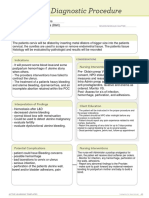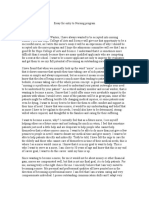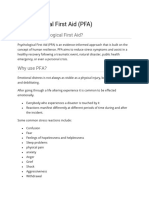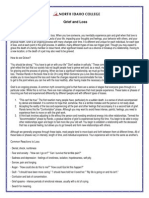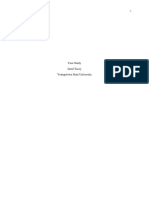The Nursing Process in Psychiatric/Mental Health Nursing
The Nursing Process in Psychiatric/Mental Health Nursing
Uploaded by
TommieCopyright:
Available Formats
The Nursing Process in Psychiatric/Mental Health Nursing
The Nursing Process in Psychiatric/Mental Health Nursing
Uploaded by
TommieOriginal Title
Copyright
Available Formats
Share this document
Did you find this document useful?
Is this content inappropriate?
Copyright:
Available Formats
The Nursing Process in Psychiatric/Mental Health Nursing
The Nursing Process in Psychiatric/Mental Health Nursing
Uploaded by
TommieCopyright:
Available Formats
Chapter 9
The Nursing Process in Psychiatric/Mental
Health Nursing
Copyright © 2014. F.A. Davis Company
The Nursing Process
• It is a systematic framework for the delivery of
nursing care.
• It uses a problem-solving approach.
• It is goal directed, its objective being the
delivery of quality client care.
• It is dynamic, not static.
Copyright © 2014. F.A. Davis Company
Standards of Practice
• The standards of practice for psychiatric
nursing are written around the six steps of
the nursing process.
1. Assessment. Information is gathered from
which to establish a client database.
Copyright © 2014. F.A. Davis Company
Standards of Practice (cont.)
2. Diagnosis. Data from the assessment
are analyzed. Diagnoses and potential
problem statements are formulated and
prioritized.
Copyright © 2014. F.A. Davis Company
Standards of Practice (cont.)
3. Outcomes identification. Expected outcomes of
care are identified. They must be measurable and
estimate a time for attainment.
• Nursing Outcomes Classification (NOC) is a
comprehensive, standardized classification of
patient outcomes developed to evaluate the
effects of nursing interventions.
Copyright © 2014. F.A. Davis Company
Standards of Practice (cont.)
4. Planning. Evidence-based interventions for
achieving the outcome criteria are selected.
• Nursing Interventions Classification (NIC)
is a comprehensive, standardized language
describing treatments that nurses perform
in all settings and in all specialties.
• NIC interventions are based on research
and reflect current clinical practice.
Copyright © 2014. F.A. Davis Company
Standards of Practice (cont.)
5. Implementation. Interventions selected during the
planning stage are executed.
• Specific interventions include:
— Coordination of care
— Health teaching and health promotion
— Milieu therapy
Copyright © 2014. F.A. Davis Company
Standards of Practice (cont.)
Implementation (cont.)
• Pharmacological, biological, and integrative
therapies. These are incorporated with
clinical skills to restore the patient’s health
and prevent further disability.
Copyright © 2014. F.A. Davis Company
Standards of Practice (cont.)
• Advanced Practice Interventions
– Prescriptive authority and treatment
– Psychotherapy
– Consultation
Copyright © 2014. F.A. Davis Company
Standards of Practice (cont.)
6. Evaluation measures progress
toward attainment of expected
outcomes.
Copyright © 2014. F.A. Davis Company
Standards of Practice (cont.)
1. According to the American Nurses
Association (ANA) standards of practice for
psychiatric mental health nurses, which
specific intervention can be implemented by
any psychiatric mental health nurse
generalist?
A. Milieu therapy
B. Psychotherapy
C. Consultation
D. Prescriptive authority
Copyright © 2014. F.A. Davis Company
Standards of Practice (cont.)
• Correct answer: A
– Milieu therapy, which is the scientific structuring
of the environment in order to affect behavioral
change, is a nursing intervention that can be
implemented by any psychiatric mental health
nurse generalist.
Copyright © 2014. F.A. Davis Company
Why Nursing Diagnosis?
• The identification and classification of nursing
phenomena began in 1973 with the First National
Conference on Nursing Diagnosis.
• Both general and specialty standards are written
around the six steps of the nursing process, of which
nursing diagnosis is an inherent part.
• It is defined in most state nursing practice acts as a
legal responsibility of nursing.
• It promotes research in nursing.
Copyright © 2014. F.A. Davis Company
Why Nursing Diagnosis? (cont.)
2. Which nursing diagnosis is written correctly?
A. Risk for social isolation related to low self-esteem
evidenced by staying in room during the day.
B. Low self-esteem related to major depressive disorder
evidenced by childhood abuse.
C. Imbalanced nutrition: less than body requirements related
to suspiciousness evidenced by 20 lbs weight loss.
D. Conduct disorder related to childhood sexual abuse
evidenced by hostile and aggressive behaviors.
Copyright © 2014. F.A. Davis Company
Why Nursing Diagnosis? (cont.)
• Correct answer: C
– “Imbalanced nutrition: less than body
requirements related to suspiciousness evidenced
by 20 lbs weight loss” is a correctly written
nursing diagnosis. Evidence of a nutritional
problem is documented and the cause of the
problem, suspiciousness, is identified.
“Imbalanced nutrition: less than body
requirements” is an approved NANDA diagnostic
stem.
Copyright © 2014. F.A. Davis Company
Nursing Case Management
• Case management is a health delivery process whose
goals are to provide quality health care, decrease
fragmentation, enhance the client’s quality of life, and
contain costs.
• Managed care is a concept designed to control the
balance between cost and quality of care. Individuals
receive care based on need, which is determined by
coordinators of the providership.
Copyright © 2014. F.A. Davis Company
Nursing Case Management (cont.)
• The case manager is the individual
responsible for negotiating with
multiple health-care providers to
obtain a variety of services for the client.
• Critical Pathways of Care (CPCs) are the tools for
provision of care in a case management system. CPCs
are abbreviated plans of care on which outcome-
based guidelines for goal achievement within a
designated length of time have been established.
Copyright © 2014. F.A. Davis Company
Nursing Case Management (cont.)
– CPCs are used by the entire interdisciplinary team. They
determine which categories of care will be provided, by
what date, and by whom.
– Nurses may be identified as case managers and are
ultimately responsible for ensuring that goals on the CPC
are achieved within the designated time dimension.
– CPCs may be standardized because they are intended to be
used with uncomplicated cases. A CPC can be viewed as a
protocol for clients with problems for which a designated
outcome can be predicted.
Copyright © 2014. F.A. Davis Company
Applying Nursing Process
Role of the Nurse in Psychiatry
• To assist with the client’s successful adaptation to
stressors within the environment
• Goals are directed toward change in thoughts,
feelings, and behaviors that are age-appropriate and
congruent with local and cultural norms.
• The nurse is a valuable member of the
interdisciplinary team providing a service that is
unique and based on sound knowledge of
psychopathology, scope of practice, and legal
implications of the role.
Copyright © 2014. F.A. Davis Company
Concept Mapping
• A diagrammatic teaching and learning strategy
• Shows interrelationships among medical and nursing
diagnoses, assessment data, and treatments.
• They are practical, realistic, and time-saving.
• They enhance critical thinking skills.
Copyright © 2014. F.A. Davis Company
Concept Mapping (cont.)
• Based on the components of the nursing
process
• Helps students develop a holistic view of their
clients
Copyright © 2014. F.A. Davis Company
Documentation of the Nursing Process
• Documentation of the steps of the nursing
process is often considered as evidence in
determining certain cases of negligence by
nurses.
• It is also required by some agencies that
accredit health-care organizations.
Copyright © 2014. F.A. Davis Company
Documentation of the Nursing Process
(cont.)
Examples of documentation that reflect
the use of the nursing process:
•Problem-Oriented Recording (POR)
– Has a list of problems as its basis
– Uses subjective, objective, assessment, plan,
intervention, and evaluation (SOAPIE) format
Copyright © 2014. F.A. Davis Company
Documentation of the Nursing Process
(cont.)
• Focus Charting
– Main perspective is to choose a “focus” for
documentation. A focus may be:
• a nursing diagnosis
• a current client concern or behavior
• a significant change in the client’s status or behavior
• a significant event in the client’s therapy
– The focus cannot be a medical diagnosis.
– Focus charting uses data, action, and response
(DAR) format.
Copyright © 2014. F.A. Davis Company
Documentation of the Nursing Process
(cont.)
• APIE method
– A problem-oriented system
– Uses flow sheets as accompanying documentation
– Uses assessment, problem, intervention, and
evaluation (APIE) format
Copyright © 2014. F.A. Davis Company
Documentation of the Nursing
Process (cont.)
3. Which charting entry is an example of the
documentation of a subjective symptom?
A. Temperature 101.4o F
B. No muscle rigidity or drooling noted
C. Client is hypervigilant and scanning the
environment.
D. Client states, “I’m seeing green men in my room.”
Copyright © 2014. F.A. Davis Company
Documentation of the Nursing Process
(cont.)
• Correct answer: D
– The client statement, “I’m seeing green men in my
room,” is documentation of a subjective symptom
reported by the client.
Copyright © 2014. F.A. Davis Company
Electronic Documentation
• Most health-care facilities have implemented—or
are in the process of implementing—some type of
electronic health records (EHRs) or electronic
documentation system.
• EHRs have been shown to
improve both the quality of
client care and the efficiency
of the health-care system.
Copyright © 2014. F.A. Davis Company
Electronic Documentation (cont.)
• Eight Core Functions of EHRs:
– Health information and data
– Results management
– Order entry/order management
– Decision support
– Electronic communication and connectivity
– Patient support
– Administrative processes
– Reporting and population health management
Copyright © 2014. F.A. Davis Company
Advantages and Disadvantages of
Paper and EHR Charting
• Paper • EHRs
– Advantages – Advantages
• Fast • Accessed by many
• Portable • Facilitates research
• People know it and billing
• Reduces errors
– Disadvantages
– Disadvantages
• Can be lost
• Expensive
• Hard to read • Large learning curve
• Hard to store for new users
• Difficult to research • Technical difficulties
Copyright © 2014. F.A. Davis Company
You might also like
- ANA StandardsDocument1 pageANA Standardsointeriano100% (1)
- Waiters Teaching New Parents PDFDocument1 pageWaiters Teaching New Parents PDFTommieNo ratings yet
- Documentation in Psychiatric NursingDocument15 pagesDocumentation in Psychiatric NursingShiiza Dusong Tombucon-Asis86% (7)
- Eating Disoder PPT 3Document22 pagesEating Disoder PPT 3Jordz PlaciNo ratings yet
- Therapeutic Communication PowerpointDocument29 pagesTherapeutic Communication Powerpointjoycechicago100% (6)
- Abraham Flexner Six Criteria of A ProfessionDocument1 pageAbraham Flexner Six Criteria of A ProfessionSonya Robb100% (4)
- Introduction To MH-psychiatric NursingDocument53 pagesIntroduction To MH-psychiatric NursingFavour Joshua MpumurijeNo ratings yet
- Quality Assurance in Mental Health and Psychiatric NursingDocument16 pagesQuality Assurance in Mental Health and Psychiatric NursingteuuuuNo ratings yet
- Psychiatric Nursing PPT Lecture YesDocument50 pagesPsychiatric Nursing PPT Lecture YesSusan Maglaqui100% (1)
- Module 4 Standards of Psychiatric-Mental Health Nursing PracticeDocument9 pagesModule 4 Standards of Psychiatric-Mental Health Nursing Practicejoyrena ochondraNo ratings yet
- MRI - Nursing ResponsibilitiesDocument3 pagesMRI - Nursing ResponsibilitiesRNdrei dela Cruz0% (1)
- LESSON PLAN SeminarDocument6 pagesLESSON PLAN SeminarAnand BhawnaNo ratings yet
- Bio Physiological MethodsDocument4 pagesBio Physiological MethodsDelphy Varghese100% (2)
- Principles of Psychiatric NursingDocument26 pagesPrinciples of Psychiatric NursingShamala Anjanappa100% (4)
- Unit Plan 2nd YearDocument8 pagesUnit Plan 2nd YearPrashanth Padmini Venugopal100% (1)
- Waiters Postpartal Hemorrhage PDFDocument1 pageWaiters Postpartal Hemorrhage PDFTommieNo ratings yet
- Human Figure Drawing TestDocument2 pagesHuman Figure Drawing TestEleonor Dapig100% (4)
- Formulation of NCPDocument8 pagesFormulation of NCPSandeep choudharyNo ratings yet
- 04 Nursing Process of MHNDocument13 pages04 Nursing Process of MHNamit100% (1)
- Mhn-Issues, Trends, Magnitude, Contemporary Practice HealthDocument15 pagesMhn-Issues, Trends, Magnitude, Contemporary Practice HealthAna MikaNo ratings yet
- Mental Health Act PDFDocument40 pagesMental Health Act PDFAnilkumar JaraliNo ratings yet
- Mental Health Nursing Evaluation Criteria For Clinical PresentationDocument6 pagesMental Health Nursing Evaluation Criteria For Clinical PresentationSumit YadavNo ratings yet
- Annotated BibliographyDocument4 pagesAnnotated Bibliographymerin sunilNo ratings yet
- Lesson Plan On DeliriumDocument5 pagesLesson Plan On DeliriumAnkush Kulat Patil100% (1)
- R.sreevani - Seminar PresentationDocument86 pagesR.sreevani - Seminar PresentationGiridhar Ambati100% (3)
- Standards of Psychiatric Nursing, Current Trends in Psychiatric NursingDocument6 pagesStandards of Psychiatric Nursing, Current Trends in Psychiatric NursingSukanyareddyNo ratings yet
- Quality AssDocument57 pagesQuality AssShailja Sharma50% (2)
- BpadDocument27 pagesBpadnikitabhattarai20No ratings yet
- Unit Course MSC NursingDocument15 pagesUnit Course MSC NursingPriyanka JohnNo ratings yet
- Concept of PsychobiologyDocument21 pagesConcept of Psychobiologydhivyaram100% (1)
- Lesson Plan MDTDocument21 pagesLesson Plan MDTchaitali shankarNo ratings yet
- Nursing Management of DepressionDocument8 pagesNursing Management of DepressionHisabu Mohammed100% (3)
- 2.3. Mental Health Nursing: Course DescriptionDocument5 pages2.3. Mental Health Nursing: Course Descriptioncharanjit kaurNo ratings yet
- Principles of Mental Health Nursing Standard's of Mental Health NursingDocument14 pagesPrinciples of Mental Health Nursing Standard's of Mental Health NursingSimran Josan100% (3)
- BibliographyDocument5 pagesBibliographyanurajoneNo ratings yet
- Question Paper Blue Print Mental Health Nursing - B.SC - Iii Year - 1770Document2 pagesQuestion Paper Blue Print Mental Health Nursing - B.SC - Iii Year - 1770S N K KichhaNo ratings yet
- Ocd Prac Teach Plan Rescue FileDocument14 pagesOcd Prac Teach Plan Rescue Filevikas tak100% (2)
- Planning Equipments and Supplies For Nursing CareDocument21 pagesPlanning Equipments and Supplies For Nursing Carejagraj14775% (4)
- History of Nursing in NepalDocument24 pagesHistory of Nursing in NepalSirpa Mhrzn100% (1)
- Non Asertive BehaviourDocument7 pagesNon Asertive BehaviourSushma ShahiNo ratings yet
- Process RecordingDocument4 pagesProcess RecordingSheena Moses100% (1)
- Lesson Plan: Previous KnowledgeDocument9 pagesLesson Plan: Previous KnowledgeSimran Josan100% (2)
- CU 13. The Role of The Nurse EducatorDocument10 pagesCU 13. The Role of The Nurse EducatorWonie booNo ratings yet
- 'MUHS RESEARCH - Final - 1-1Document31 pages'MUHS RESEARCH - Final - 1-1Reshma rsrNo ratings yet
- Recreational Therapy Presentee: Sukhdeep Kaur Msc. (N) 1 YearDocument26 pagesRecreational Therapy Presentee: Sukhdeep Kaur Msc. (N) 1 YearSatbir GillNo ratings yet
- Current Trends An Issues in Psychiatric NursingDocument7 pagesCurrent Trends An Issues in Psychiatric Nursingshalini sahu100% (1)
- PROCESS RECORDING-1 CorectedDocument5 pagesPROCESS RECORDING-1 CorectedPallabi SethNo ratings yet
- Mental Health TeamDocument3 pagesMental Health Teammanu sethiNo ratings yet
- Family Health Nursing: Ms - Neethu Vincent Asst Professor KVM College of NursingDocument9 pagesFamily Health Nursing: Ms - Neethu Vincent Asst Professor KVM College of NursingNeethu VincentNo ratings yet
- Introduction To Self:: Time Specific Objective Content Teaching AND Learning Activity EvaluationDocument20 pagesIntroduction To Self:: Time Specific Objective Content Teaching AND Learning Activity EvaluationKiran Kour100% (2)
- Bipolar NCPDocument2 pagesBipolar NCPAngel BunolNo ratings yet
- Process RecordingDocument9 pagesProcess RecordingShiva CharakNo ratings yet
- Health AssessmentDocument115 pagesHealth Assessmentteuuuu100% (1)
- Evaluation of Educational Programme in Nursing Course and Programme IntroducationDocument8 pagesEvaluation of Educational Programme in Nursing Course and Programme Introducationkirandeepdhaliwal09050% (2)
- Process Recording FinalDocument32 pagesProcess Recording FinalRiteka SinghNo ratings yet
- Subjective:: Assessment Nursing Diagnosis Planning Interventions Rationale Evaluation Nursing Nursing Care Plan: ManiaDocument1 pageSubjective:: Assessment Nursing Diagnosis Planning Interventions Rationale Evaluation Nursing Nursing Care Plan: ManiaJasmine BaduaNo ratings yet
- Unit 5 Factors Affecting The Healthcare SystemDocument29 pagesUnit 5 Factors Affecting The Healthcare SystemYuri Chan100% (1)
- Mental Health &mental Illness PPT (1) - 2Document75 pagesMental Health &mental Illness PPT (1) - 2N.a.s.r EbaidNo ratings yet
- Process Recording 3Document24 pagesProcess Recording 3qpj56mgp58No ratings yet
- Lesson 2 Reviewer - Decision Making and PlanningDocument3 pagesLesson 2 Reviewer - Decision Making and PlanningmanuelNo ratings yet
- Lesson 2 Reviewer - Decision Making and PlanningDocument3 pagesLesson 2 Reviewer - Decision Making and PlanningmanuelNo ratings yet
- Organizing Practices For Pharmaceutical Care FinalDocument52 pagesOrganizing Practices For Pharmaceutical Care FinalAnish GhaleNo ratings yet
- Chapter 4. Developing Your Practice Facilitation Approach: Create A Key-Driver Model For Your PF InterventionDocument15 pagesChapter 4. Developing Your Practice Facilitation Approach: Create A Key-Driver Model For Your PF InterventionYhanna UlfianiNo ratings yet
- Waiters Pulmonary Embolism Form PDFDocument1 pageWaiters Pulmonary Embolism Form PDFTommie0% (1)
- Waiters Pulmonary Function Test PDFDocument1 pageWaiters Pulmonary Function Test PDFTommie0% (1)
- Waiters Osteoarthritis PDFDocument1 pageWaiters Osteoarthritis PDFTommieNo ratings yet
- Waiters Nonstress Test PDFDocument1 pageWaiters Nonstress Test PDFTommieNo ratings yet
- Waiters Rheumatoid Arthritis PDFDocument1 pageWaiters Rheumatoid Arthritis PDFTommie100% (1)
- Waiters Morphine PDFDocument2 pagesWaiters Morphine PDFTommieNo ratings yet
- Waiters-PneumoniaSystem Disorder Form PDFDocument1 pageWaiters-PneumoniaSystem Disorder Form PDFTommieNo ratings yet
- Hope College of Arts & Sciences: Program of Study PlanDocument2 pagesHope College of Arts & Sciences: Program of Study PlanTommieNo ratings yet
- Waiters Rhabdomyolysis PDFDocument1 pageWaiters Rhabdomyolysis PDFTommieNo ratings yet
- Waiters Tommie Alajandro 1757 1068397665 Awp PDFDocument771 pagesWaiters Tommie Alajandro 1757 1068397665 Awp PDFTommieNo ratings yet
- Waiters. Eng 101Document3 pagesWaiters. Eng 101TommieNo ratings yet
- Waiters Uterine Curette PDFDocument1 pageWaiters Uterine Curette PDFTommieNo ratings yet
- Waiters Salmeterol PDFDocument1 pageWaiters Salmeterol PDFTommieNo ratings yet
- Waiters PATIENT CARE PLAN 2020 For PPHDocument3 pagesWaiters PATIENT CARE PLAN 2020 For PPHTommieNo ratings yet
- Waiters Remdesivir - Drug - CardDocument6 pagesWaiters Remdesivir - Drug - CardTommieNo ratings yet
- Waiters Newborn Care PDFDocument1 pageWaiters Newborn Care PDFTommieNo ratings yet
- Waiters Proning PDFDocument1 pageWaiters Proning PDFTommieNo ratings yet
- Acceptance LetterDocument2 pagesAcceptance LetterTommieNo ratings yet
- Waiters, Tommie POS Spring 2019 PDFDocument2 pagesWaiters, Tommie POS Spring 2019 PDFTommieNo ratings yet
- 326 Mental - Status - Examination Directions and RubricDocument4 pages326 Mental - Status - Examination Directions and RubricTommieNo ratings yet
- Pneumonia Nursing Care Plans: Short Term: Short Term: After 3-4Document2 pagesPneumonia Nursing Care Plans: Short Term: Short Term: After 3-4esteffie21No ratings yet
- 20 List Office SuppliesDocument2 pages20 List Office SuppliesTommieNo ratings yet
- Movie Characters and Personality DisordersDocument2 pagesMovie Characters and Personality DisordersDanielsenOsman1No ratings yet
- PTSD Research PaperDocument11 pagesPTSD Research Paperapi-548851649No ratings yet
- Early Childhood Tutor: Itinerant Teacher 1999Document190 pagesEarly Childhood Tutor: Itinerant Teacher 1999MultazamNo ratings yet
- The Theory and Practice of Structural and Strategic Family Therapies - A Delphi StudyDocument13 pagesThe Theory and Practice of Structural and Strategic Family Therapies - A Delphi Studydiablero999No ratings yet
- The Effect of Architecture and Design On Mental Health and ImplicDocument34 pagesThe Effect of Architecture and Design On Mental Health and ImplicClarisse DoriaNo ratings yet
- Lps ManualDocument60 pagesLps ManualPeter PiperNo ratings yet
- Dissociative DisordersDocument2 pagesDissociative DisordersriejeancalimotNo ratings yet
- People v. Opuran, G.R. Nos. 147674-75, 17 March 2004Document6 pagesPeople v. Opuran, G.R. Nos. 147674-75, 17 March 2004Anna BarbadilloNo ratings yet
- Bhopal (M.P.) : Assignment OnDocument9 pagesBhopal (M.P.) : Assignment OnamitNo ratings yet
- Yoga As An Important Aspect For Spiritua PDFDocument5 pagesYoga As An Important Aspect For Spiritua PDFbskanwar6376No ratings yet
- What Is Psychological First Aid?Document4 pagesWhat Is Psychological First Aid?Jianica SalesNo ratings yet
- Theories of NeurosisDocument170 pagesTheories of NeurosisemilvulcuNo ratings yet
- Spiritual Crisis and RecoveryDocument8 pagesSpiritual Crisis and RecoveryMatt AldridgeNo ratings yet
- Module-1 Notes - 22SFH18 PDFDocument48 pagesModule-1 Notes - 22SFH18 PDFmaheshanischithaNo ratings yet
- English 6: After The Entire Discussion, The Pupils Will Be Able ToDocument17 pagesEnglish 6: After The Entire Discussion, The Pupils Will Be Able ToRonald RyanNo ratings yet
- The Professional Competencies of A European PsychotherapistDocument32 pagesThe Professional Competencies of A European PsychotherapistTiago SantosNo ratings yet
- The TAPS Project. 8: Design of The Research Study On The Long-Stay PatientsDocument7 pagesThe TAPS Project. 8: Design of The Research Study On The Long-Stay PatientspaolaNo ratings yet
- Dflex 2011Document7 pagesDflex 2011Carla CascianiNo ratings yet
- Gangguan MakanDocument36 pagesGangguan MakanRyan Trian100% (1)
- Positive Thinking PatternsDocument4 pagesPositive Thinking PatternsjugoslavijaNo ratings yet
- Vol 7 PDFDocument304 pagesVol 7 PDFLê HằngNo ratings yet
- The Relationship Between Mental Disorders and Different Types of CrimeDocument15 pagesThe Relationship Between Mental Disorders and Different Types of CrimeКсенияNo ratings yet
- Aggression and Violent BehaviorDocument8 pagesAggression and Violent BehaviorRizky Dian PratiwiNo ratings yet
- Grief LossDocument2 pagesGrief LossKailash NagarNo ratings yet
- Baby BluesDocument3 pagesBaby BluesMilikPremiumstock90No ratings yet
- Case Study Jared Tacey Youngstown State UniversityDocument13 pagesCase Study Jared Tacey Youngstown State Universityapi-402076669100% (1)
- Your Own Mind Will Be The Killer: and Everyone Feels Extremely Sad or Angry Sometimes in His or Her Life. Those EmotionsDocument2 pagesYour Own Mind Will Be The Killer: and Everyone Feels Extremely Sad or Angry Sometimes in His or Her Life. Those EmotionsrenNo ratings yet
- Strategy Intervention To Prevent and Reduce Postpartum Depression: A Systematic ReviewDocument6 pagesStrategy Intervention To Prevent and Reduce Postpartum Depression: A Systematic Reviewevania nitaNo ratings yet
- The Effects of Owning A Pet On Self-Esteem and Self-Efficacy of Malaysian Pet OwnersDocument7 pagesThe Effects of Owning A Pet On Self-Esteem and Self-Efficacy of Malaysian Pet OwnersSunway University0% (1)

